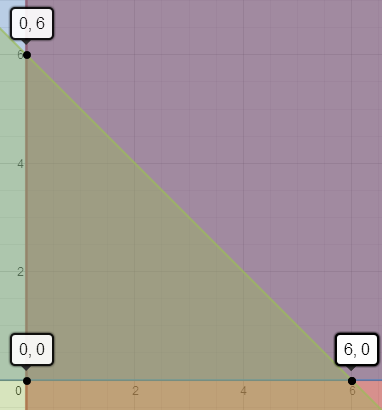Wednesday, May 14, 2014
Monday, April 28, 2014
Tuesday, April 1, 2014
Wednesday, March 19, 2014
Linear Programming
|
|
||||||||
Vertices:
|
||||||||
Constraints
|
Objective Function: 3x + 4y
|
|||||||
x ≥
0
y ≥
0
x + y ≤ 6
|
24
|
0
|
18
|
|||||
|
|
||||||||
Vertices:
|
||||||||
Constraints
|
Objective Function: 2x + 5y
|
|||||||
x ≤ 5
y ≥ 4
-2x + 5y ≤ 30
|
10
|
30
|
20
|
|||||
Vertices:
|
||||||||
Constraints
|
Objective Function: 7x + 3y
|
|||||||
x ≥ 1
y ≥ 2
6x + 4y ≤ 38
|
31
|
13
|
41
|
|||||
|
|
||||||||
Vertices:
|
||||||||
Constraints
|
Objective Function: 4x + 6y
|
|||||||
x ≥
0
y ≤ 8
-2x + 3y ≥ 12
|
48
|
24
|
72
|
|||||
|
|
||||||||
Vertices:
|
||||||||
Constraints
|
Objective Function: 8x + 7y
|
|||||||
x ≥
0
y ≥ 0
4x + 4y ≤ 20
x + 2y ≤ 8
|
0
|
35
|
37
|
64
|
||||
Vertices:
|
(0,4)
|
(0,2)
|
(3,0)
|
(4,3)
|
||||
Constraints
|
Objective Function: 3x + 5y
|
|||||||
x ≥
0
2x +3y ≥ 6
3x - y ≤ 9
x +4y ≤ 16 |
20
|
10
|
9
|
27
|
||||
Monday, March 10, 2014
Friday, February 28, 2014
Compound Interest Formula
Compound Interest: Interest calculated on the initial principal and also on the accumulated interest of previous periods of a deposit or loan.

P = principal amount (the initial amount you borrow or deposit)
r = annual rate of interest (as a decimal)
t = number of years the amount is deposited or borrowed for.
n = number of times the interest is compounded per year
Tuesday, February 25, 2014
Tuesday, February 18, 2014
Graphing Exponential Growth/Decay
- Graphing Exponential Growth/Decay
1. Create the Parent Graph.
2. Identify A,H,K.
3. Create your new T-Chart.
- Domain: All real #'s.
- Range: y>k; when a is positive. y<k; when a is negative.
- Asymptote: y=k.
4. Draw Asymptote.
5. Graph new points.
- Exponential Formula: y=a×bx-h+k
- a = multiplier.
0<a<1 = compression
a< 0(negative) = flipped over x-axis.
- b = base
0<b<1 = fraction; decay, always decreasing.
B is never negative only the multiplier is.
- h = lf/rt; opposite
- k = up/dn
General Forms of a Sequence
GENERAL FORMS OF A SEQUENCE
Arithmetic sequence formula- In an Arithmetic Sequence the difference between one term and the next is a constant. Also called the Common Difference.
Geometric sequence formula- In a Geometric Sequence each term is found by multiplying the previous term by a constant. Also called the Common Ratio.
Example:
| 2, 4, 8, 16, 32, 64, 128, 256, ... |
This sequence has a factor of 2 between each number. Each term (except the first term) is found by multiplying the previous term by 2.
Finite sequence- Is a function with domain 1,2,3.Infinite sequence- Is a function with domain 1,2,3,4.... etc.
Series- Is the sum of a sequence.
Explicit formula- Each domain is an answer not based on any values.
Recursive Formula- Each domain is a answer based on a previous answer.
Wednesday, January 15, 2014
Characteristics and Traits of a Graph
The descriptions for each is posted below.
Range- Y-Values
End Behavior- Describing the two ends of the graph. While X approaches negative infinity, Y approaches negative infinity. While X approaches positive infinity, Y approaches positive infinity and vice versa in another situation.
x→∞, y→∞. x→-∞,y→-∞
Absolute Max/Min- 1 point that has the highest/lowest point on a graph.
A specific point on the graph.
Local Max/Min- More than 1 point on a graph at its highest/lowest point.
Interval of Increase- Section of a graph where the y-values increase.
Interval of Decrease- Section of a graph where the y-values decrease.
Y-Intercept- Where the line(s) cross over the y-axis.
Symmetry- Even/Odd/Neither
Even- The graph is symmetrical over the y-axis.
Odd- The graph is symmetrical about the origin.
Neither- The graph is not symmetrical at all.
Asymptotes- Imaginary line that the graph gets closer and closer too but never touches.
Function- The graph passes the vertical line test. The equation only has 1 x-value per y-value.
One to One- The graph pass the vertical and horizontal line test.
Subscribe to:
Comments (Atom)












